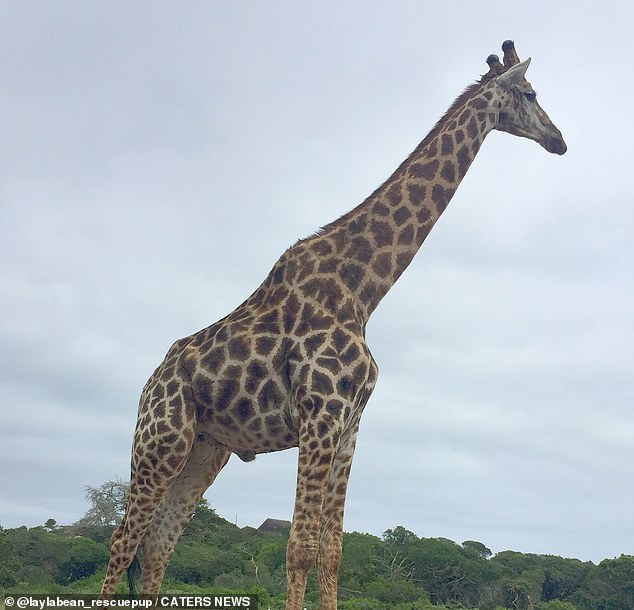The knobby ‘horns’ on top of a giraffe’s head may act like a dangerous lightning rod, according to a conservation scientist in South Africa.
Two female giraffes were found dead at Rockwood wildlife reserve in Northern Cape after a sudden lightning storm in February.
When rangers investigated, they found that one of the older giraffe’s antler-like nubs, called an ossicone, was badly damaged – possibly from a direct lightning strike.
‘It looked like the ossicone broke off,’ Ciska Scheijen, a conservationist at Rockwood, told New Scientist.
In a recent report in the African Journal of Ecology, Scheijen suggested that given that lightning tends to hit tall objects, ‘the height of giraffes may make them particularly vulnerable to fatal electrocution.’
That vulnerability could be influencing natural selection, she said.
Scroll down for video
Two female giraffes were found dead at at South Africa wildlife reserve after a lightning storm. Severe damage to one’s antler, and the smell of amonia, led rangers to believe they had been killed in a lightning strike
Scheijen had been studying Rockwood’s herd of eight giraffes for nearly a year and was surprised when, after the storm abated, she saw only six.
‘It’s very rare for that group to separate,’ she said.
About 20 feet away from the matriarch was the lifeless body of a young female giraffe.
The calf was probably killed by a side flash, when lightning jumps one object to another, or by ground current traveling from the older giraffe.

In a recent report, conservationist Ciska Scheijen suggested giraffes’ height makes them more vulnerable to direct strikes by lightning. She recommended more research to see if the phenomenon impacted natural selection
There was also the powerful odor of ammonia, Scheijen said, typical of lightning strikes on living creatures.
That smell may have kept scavengers away, as the animals’ carcasses were mostly undisturbed.
Given the lack of scholarship on lightning strikes on animals it’s not clear if giraffes seek shelter from taller trees during thunderstorms.
‘It’s possible that this happens more often to giraffes than other species because of their height,’ Scheijen told New Scientist. ‘But I think more research is needed to see if this has an effect on the natural selection of giraffes.’
Lightning kills an estimated 24,000 people a year and injures 10 times that many.
Experts believe climate change is increasing the frequency of strikes and changes in land use are exacerbating their effects.
But exactly how much risk giraffes are in of being struck is up for debate.
‘I can think of a number of cases where a giraffe has been killed by lightning, both from a direct hit and by being struck by a tree that it was standing beneath,’ Julian Fennessy, chair of the International Giraffe Working Group, told the BBC.
‘But it is still quite rare… Hazarding a guess, we have one or two cases a year.’
Fennessy doesn’t believe giraffes are zoological lightning rods, though – any animal caught in the wrong place at the wrong time could be struck.
In a thunderstorm, giraffes in the wild may seek shelter under taller trees.
In zoos and safaris, though, they may be the tallest thing around.

Experts believe climate change is increasing the frequency of strikes. But exactly how much risk giraffes are in is unknown, as is whether they’re more at risk in the wild or in zoos
Some scientists say it’s the greater distance between a giraffe’s legs, not their height, that make it more likely electric current will flow toward one when lightning strikes.
In May 2019, two giraffes at Lion Country Safari in Loxahatchee, Florida, were killed instantly by lightning during a sudden thunderstorm.
It’s likely a bolt struck the pasture Lily and Jioni were in and the current traveled outward, safari spokesperson Haley Passeser said, rather than both animals being struck directly in two separate incidents.
Workers had opened the pair’s covered shelters, but Lily and Jioni didn’t want to go inside.
‘If they don’t choose to seek shelter, there isn’t a lot we can do to encourage them to,’ Passeser told WPBF. ‘For them it is more safe and more comfortable for them to be out in the open environment and understand what’s going on around them.’
But the real threat to giraffes is humans, not weather. Development threaten their habitats and poachers hunt them for bushmeat and because their brains supposedly contain a cure for HIV/AIDS
Some 40 percent of giraffes have disappeared since the 1980s, with only 68,000 remaining in the wild.
Of the nine subspecies of giraffe, six are listed in threatened categories, ranging from near threatened to critically endangered.
Stringent conditions on the trade of giraffes were enacted last year.
The Rockwood reserve focuses on rhinoceros, but it also protects a small population of giraffes for research purposes.
Conservationists collect samples of the hormone glucocorticoid to determine the giraffes’ stress levels.
The hope is to improve their relocation process and help create viable breeding herds.
Rather than take blood samples, though, researchers follow the animals on horseback and wait until they defecate.
‘Then we quickly collect the feces for testing. The samples must be less than half an hour old when collected as the metabolism of the hormone continues even outside the body.’
